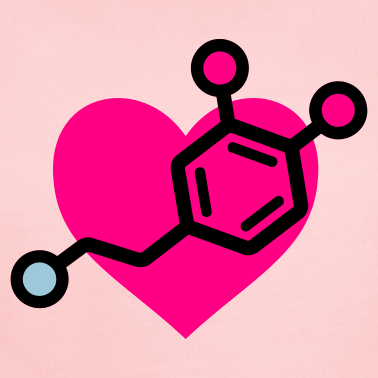When we meet someone that we like, our heart flutters and we feel short of breath. On a first date, our stomach is full of butterflies. And when we fall in love, we feel a powerful sense of empathy towards our partner.
While poets, novelists, and songwriters have described the feeling of love in countless types of verse, attraction at the biological level boils down to simple chemistry. In fact, falling in love equates to about 79 carbon atoms, 117 hydrogen atoms, 14 nitrogen atoms, 19 oxygen atoms, and two sulfur atoms— all of which comprise four critical hormones: testosterone, adrenaline, dopamine, and oxytocin.
Hormones are secreted compounds that are produced by specific cells, glands, or tissues. They travel throughout the body and influence many physiological and behavioural activities, including digestion, metabolism, growth, and, in the case of these hormones, attraction. Though you can’t see or feel them, these tiny molecules have a huge influence on who you find attractive and, ultimately, with who you fall in love.
Testosterone
Commonly known for its role as a male sex hormone, testosterone is actually present in both men and women, and plays a pivotal role in fostering sexual attraction. It’s responsible for increasing sexual arousal and focused attention on the person of interest, making it one of several chemicals guilty of inspiring lust. While testosterone is present in higher concentrations in men, a study published by Northwestern University in 2012 suggests that mutual attraction actually induces a hormonal testosterone spike in both parties.
The study consisted of approximately 200 heterosexual men and women who volunteered to take part in about 2000 speed dates. Participants were required to provide researchers with four saliva samples for hormonal analysis. Two were taken a week before the speed-dates, while one was taken right before and another right after.
The samples showed that testosterone levels remained stable during one-sided attraction, but sharply increased when mutual attraction was experienced.
“Many people think that only men have testosterone, but that’s not the case,” said Eli Finkel, the lead author of the study. “It’s true that men have much more testosterone than women do, but the links between testosterone and social outcomes are similar for men and women, and testosterone is associated with a stronger sex drive in both sexes.”
The study gives rise to interesting questions concerning sexual attraction—how accurate are people at detecting this mutual attraction, and are testosterone levels related to some people being better at detecting it than others?
Adrenaline
When you meet someone new, this fight or flight hormone is responsible for the butterfly feeling in your stomach and racing pulse. According to Reginald Ho, a cardiac electrophysiologist and associate professor of medicine at Thomas Jefferson University Hospital, the brain sends a signal to the adrenal gland, which secretes adrenaline to the blood. The hormone then travels until it reaches various organs on which it has a physiological effect. For instance, when adrenaline reaches the heart, it binds to a specific receptor called the adrenergic receptor expressed on the heart tissue. Binding to this receptor triggers an increase in heart rate. Adrenaline is the same hormone that is released when we are frightened or stressed, which may go to explain the feeling of nervousness we experience when meeting someone we find attractive.
Dopamine
Anthropologist and human behaviour researcher Helen Fisher conducted an experiment where she scanned the brains of young couples to see what areas of the brain lit up when they focused on the object of their affection. One of these areas was associated with dopamine—a hormone that helps control the brain’s reward and pleasure centers. Not only does dopamine enable us to see rewards, it also provokes people to take action to move toward them.
“My prediction is that dopamine is an essential part of infatuation”, said Fisher to Psychology Today. “[The hormone] is already associated with euphoria, sleeplessness, loss of appetite, and a rush of motivation.” In other words, the dopamine response seems to induce all the symptoms we attribute to falling in love.
Oxytocin
This cuddling chemical is the hormone that activates feelings of trust and attraction between people when it is released in the brain during childbirth, breastfeeding, and sex. Unlike testosterone, adrenaline, or dopamine, oxytocin plays less of a role in sparking relationships, and plays a role in promoting monogamy.
According to a study published in the Journal of Neuroscience, oxytocin helps maintain relationships once they have started. The researchers monitored a first encounter between male study participants and a woman in a laboratory setting. When given oxytocin via an intranasal spray, men who had indicated they were currently in a stable relationship kept a greater physical distance from the woman in the lab compared to single men sprayed with the same hormone. This supports the idea that raised levels of oxytocin promote monogamy between partners.
With Valentine’s Day quickly approaching, the spotlight turns to the romantic gestures couples make towards one another. Fisher explains that, based on the chemistry of attraction, these gestures aren’t so crazy after all.
“No wonder lovers talk all night or walk till dawn, write extravagant poetry and self-revealing emails, or cross continents or oceans […] for just a weekend,” Fisher said. “Drenched in chemicals that bestow focus, stamina, and vigor […] lovers succumb to a Herculean courting urge.”









